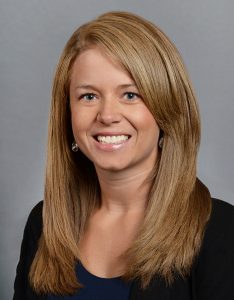Published on Nov. 13, 2019

Tina Balser, MU director of student success initiatives
Tina Balser is enthusiastic about higher education’s ever-changing technological landscape. As director of student success initiatives at MU, her main charge is to implement, evaluate and manage student success initiatives — such as the MU Connect student success technology — to maximize campus resources and effectiveness. But what really energizes Balser is people. Specifically, the Missouri Tigers who succeed and excel thanks in part to these powerful tools and the people who use them each day.
It’s that spirit that caught the attention of EDUCAUSE, a nonprofit association that advances higher education through information technology. The organization recently selected Balser as a contributor to its online publication EDUCAUSE Review. Her piece “Moving Beyond Culture: A Socio-Technical Approach to Understanding Student Success Technology Adoption” examines implementation and adoption of new technologies at academic institutions.
Why did you want to contribute to EDUCAUSE?
“EDUCAUSE is important because it provides a space for collaboration, networking and continued conversations about current issues. It creates opportunities to bring innovation and new ideas to the forefront. But it’s not just about technology. It’s about people, processes and removing barriers for students in the ever-changing higher education landscape. It was important for me to connect with them because I felt I had work to contribute, especially my dissertation work involving socio-technical theory.”
How did you arrive on the topic for your article?
“I’ve always been really interested in people and their behaviors. I love learning what makes them tick and why they do certain things in regards to the use of technology. I enjoy navigating conversations to support students’ practices. I love training folks around technology and finding ways to make it easier and more beneficial for faculty, staff and students. I also enjoy watching them navigate, helping them, and asking myself, ‘Why do you ask that question? Why did you tackle it that way? Why does this present a challenge?’ There is a huge social component to technology.”
How do you get students, staff and faculty to commit to new technologies?
“I wish that it was simple to just buy something and turn it on, but there is so much involved. We might not take the time to understand what happens between — from the time of purchase to adoption. There’s a lot of work that comes into play. Each organization, when it implements new technology, will yield new processes. It will impact the work people do every day. Take appointment scheduling for example. We have scheduled appointments with students for decades, but now we’re doing it differently via new technology and to meet new priorities. Or there’s the implementation of an early alert system, and now I have to outreach to the students. I have to raise a flag, or I have to clear a flag. That’s a task. Sometimes we lead the technology through the eyes of the technology and not through a social process … and we need to make sure this is highly intentional work to support those who use technology everyday.”
What other institutions do this type of work well?
“I think it depends on the process you’re talking about. If we’re talking about appointment scheduling, student connections and transparency of student case management, Mizzou does it really well. We have a very hands-on and transparent approach. We have a transparent way of sharing of notes and communications to help move students from point A to point B. From an early alert technology perspective, we’re at a really high level right now, and we have the right people engaged in the work and more opportunities in the near future to scale this work to support our students.”
What motivates you to do this work?
“For me, this is a humbled learning experience — the ability to take the things I’ve learned, apply it through a theory and create a tangible application to give meaning to the work that we’re doing well as a campus. But I couldn’t do it without the experiences that faculty and staff have provided me personally and professionally. They motivate me each day to continue to do this important work. I’m very thankful to help lead our campus in this work and support new initiatives.”